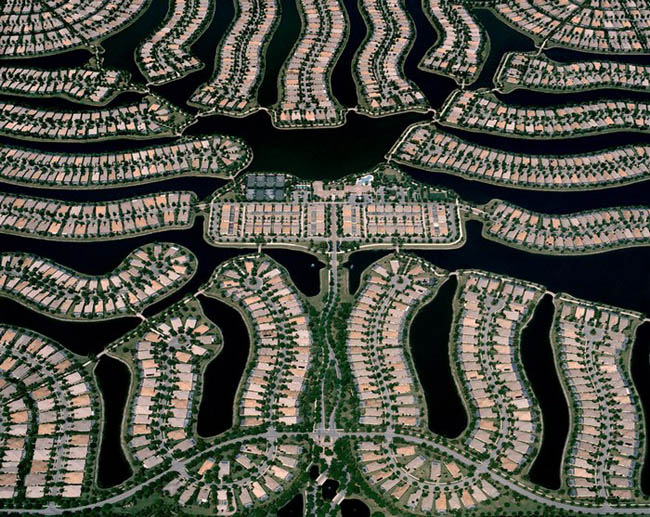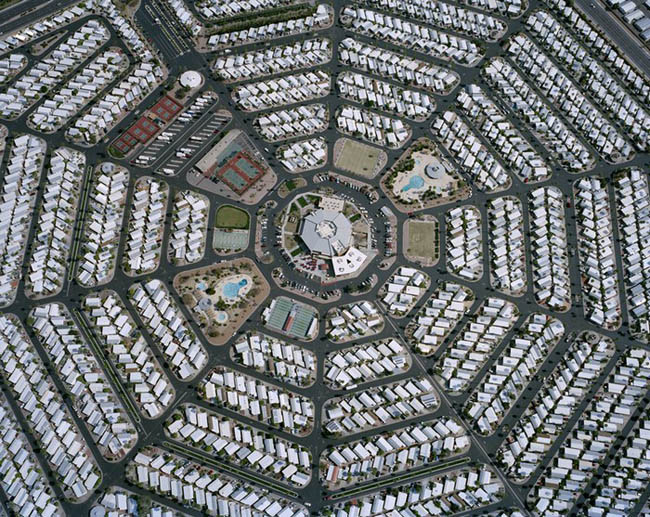Helicopter photos of suburban sprawl by Christoph Gielen reveal the beautifully-designed patterns and shapes of our auto-dependent homes on the range, walking not preferred, neighbors as yet uncontacted, wildlife unwelcome, sustainable future in question.


Car-Dependent, Hidden Behind Walls, We are all the Same
The automobile masters us, enables us, our key-started-companion and fossil fueled best-friend-forever. It commutes us to work, Sunday-drives us to play with friends, shuttling us to shopping mall strolls. Our garage-fronted homes face driveways and to-and-fro streets, connecting speedy highway strips for yoga and frozen yogurt, parking lots spreading out the space between us and everything else.
We consider the ever-repeating serpentine lines as home, units placed at angles with hue enhancements, punctuated by strips of green and blue. Family-friendly, freeway-close, happiest home on Earth. The design-engineered-beauty of the lines and patterns define the sublime suburbia, illustrated in the recurring shapes of Christoph Gielen’s aerial photographic essay.


Covenants, Codes, and Restrictions
We discourage walking. Yet, uplighted paseos abound, stippled with patterns of Mexican-imported tilework, as fountains splash water on your shoes. We prohibit cutting through yards, as are pool-hopping and freedom-running over the gazanias. No commercial signs, neon-lights, billboards blinking, hawking, manipulating the behavior of youth and the aged alike, not here, maybe there, out of view of homes. Covenants, codes, and restrictions keep the trees clipped, lawns shaved, recreation vehicles camouflaged.
Zones separate land uses, stipulated by General Plans, codified by city administrators, and interpreted by councils and supervisors. Residences stay with like-residences, density, median-income and land value grouped with their analogue. Mixing median-income condos with expensive single-family homes might create a diverse community, but like-zoning prohibits. Shopping centers, public plazas, parks and housing do not mix, townhomes don’t dwarf ranchettes, the working poor take buses to service the inner-workings, offices relegated on the left side of the freeway, industrial zone proximate to the railroad.
No mixing uses allowed, like having a kitchen next to a living room. Good planners separated sulfur-belching factories from Fido’s exercise lawn. Yet they forgot to site post offices, taco shops, elementary schools and public squares walkable from your front porch. Modern-day suburbia made these connections impossible.
STORY: Centennial Project: Suburbs Sprawl, Health & Environment Suffers


Suburban Sublimation
We invest our wealth to reside in bucolic-designed havens, protected from interaction with the millions upon millions. Talkative neighbors fenced back to restrict the dialogue, many spotted gesticulating through windshields, suspicious characters kept behind gates, monitored on video. Separation means safety, control over that which may be uncontrollable, eliminating predators and unwanted sight lines, keeping interactions limited to those on our “Friend” lists. Suburbanization sublimates the wild open and the many-too-many for regulated human-centric, without the need for having to say hello to everyone. The benefits are seductive, at least on paper.
Car-dependent urban sprawl reaches everywhere, consumes trees and bogs, rivers channelized with cement and box culverts. Impervious surfaces make driving smooth, direct the falling rain out of puddles and into segregated channels that will never fill the living room floor, no matter how close that winding river. Mountain lions and rattlesnakes are held at bay, with the view of the hills accentuated with trees imported from the Seychelles. Indigenous plant species are crowded out by tropical garden-varieties, migration routes blocked, wilderness habitat fraccionated. Designing suburbia for alternative species should also be encouraged, avoiding grading of ravines, channelization of watercourses, allowing habitats to be contiguous and connected despite the presence of luxury Italian-villa condos.
STORY: Tribute to the Late Urban History Provocateur Mike Davis


Looking Down on Forever
From the air, a mesmerizing pattern dominates, classical built-environment minimalism. People take space to breathe their own air, they inhale freedom along with their own landscaping products. This land-intensive human consumption pattern requires urbanization of raw land (i.e. conversion of open space or wilderness into human-stuff). All these spread-out-people require cars to navigate the wide spaces and bring them together with friends and family.
Yet, this model can be retrofitted with alternative transportation. Light rail, long-distance bus rapid transit, shuttles, and park-and-rides can transform and activate our disparate neighborhoods. As the open spaces are filled and densities increase, mass transit alternatives become more financially and operationally viable.
Suburbia is home, comfortable, aesthetic. Yet, connect these homes through a walkable human-scale community, we all might come together as a people. We must get out of cars if we hope to have a chance for whatever we might find, just across the way.
Updated 14 March 2024










it looks like some kind of sacred geometric designs maybe in order to control their order of us consumers, like some kind of rat in a maze. But with poisoned cheese for our goal..FUCKED UP BUT JUST TAKE THE KNOWLEDGE AND USE IT AGAINST EM!!
Pingback: Wildlife Crossings: Animals Survive with Bridges and Tunnels | WilderUtopia.com
Pingback: Sprawl vs. Open Space: “Rio Santiago” Again Threatens Orange | WilderUtopia.com